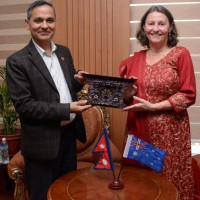- Thursday, 13 November 2025
Limited investment stifles growth of cricket talent in Nepal
Kathmandu, May 13: As Nepal is all set to take part in the T20 World Cup for the second time, more youngsters are getting attracted towards cricket and dreaming of representing the country on similar platforms. However, the structure and support at the grassroots level have led many to kill the dream and stop playing cricket for a living.
According to domestic cricketers, the services they get from playing cricket are insufficient to support the cricketer himself/herself, let alone their family.
“We are neither provided sufficient training nor any other facilities from the provincial authorities. The players get Rs. 1,600 daily as match fees during domestic tournaments. After paying for the food and lodging, we are left with Rs. 200 a day,” said Diwan Pun, a cricketer who plays for the Karnali Province Cricket Association.
Pun also revealed the struggle and financial issues of a domestic cricketer on May 5 after the match between Karnali and Gandaki at the Sahid Cup Inter-Provincial Cricket Tournament in Janakpur. His status on Facebook was shared by many other domestic cricketers and fans alongside one of the prominent Facebook pages of Nepal: Routine of Nepal Banda.
After Pun’s post, thousands of netizens have once again expressed dissatisfaction with the way domestic cricketers are being treated in the country and called the attention of the concerned authorities.
Of the seven provincial teams, one player each in the men’s and women’s teams is given a monthly salary of Rs. 25,000 by the Cricket Association of Nepal (CAN) by citing them as emerging players. It started in March after the CAN revealed a list of 30 male cricketers and 19 female cricketers to be kept under central contract.
“Except for the one player of the provincial team as per the central contract, none of the other 13-15 cricketers of any provincial team have a good income,” said Pun.
According to domestic cricketers, the rise in the number of domestic cricket tournaments has also not been beneficial as they all operate under the same structure.
“Every domestic tournament organiser, including the PM Cup, gives us Rs. 1,600 a day and cut Rs. 1,400. We were given Rs. 3,000 for food and travel by Sahid Cup organisers. After playing for a week, we do not return home with even a handful of money,” Pun exclaimed.
According to provincial officials, they have not been able to take care of their cricketers due to a shortage of money.
“The CAN provides us with Rs. 360,000 each for provincial selections of men’s and women’s senior and under-19 teams when federal-level tournaments, such as the PM Cup, are organised. We receive no further support neither from the CAN nor the provincial government,” said Kaliash Kumar Roka, secretary at the Lumbini Province Cricket Association, the winner of the Bir Ganeshman Singh National T20 Championship in April. “We try supporting our players in every way we can, but in lack of budget shortage, it is a herculean task,” Roka added.
Provincial cricket officials argued that they were awe-struck by the motivation of the youngsters to represent the country one day, but they were left saddened when the new talents could not progress further because of a lack of sufficient training and mentorship.
“We domestic cricketers have one dream: to play in the national jersey. It is what motivates us to play cricket every day despite all the hardships. We do not want our dreams to get shattered,” Pun said.
“The condition of district-level cricketers is worse. Female cricketers have bigger problems as well,” said Roka.
Way forward
Anil Kharel was one of the cricketers to share Diwan Pun’s post. Kharel, when he was 13 years old, was recognised as one of the most promising players of Nepal after he took 13 wickets, including a six-wicket haul against Oman, at the ACC-U16 Tournament in 2014.
Kharel then played for some domestic teams in Nepal over the years before debuting in the First Grade Cricket in Australia in February 2024. Kharel’s journey to Australia was a result of poor grassroots cricket in Nepal.
“There is a massive difference. The whole structure is different. It feels like our (Nepal) domestic structure is at the bottom,” said Kharel when asked about the difference in domestic crickets of Nepal and Australia.
Speaking at an interview with HamroKhelkud, an online sports news portal, CAN’s Secretary Paras Khadka accepted the poor condition of grassroots cricket in Nepal.
“We want to include the provincial and district-level cricketers, coaches and ground staff in a paid system to support every individual associated with cricket financially. However, we do not have sufficient budget,” said Khakda, who was also the captain of Nepal to lead the team to the first-ever T20 World Cup in 2014.
Khadka stressed that the CAN, after saving enough, would decentralise the money collected in the Cricketers Welfare Fund to the district and province levels. The profit made by the senior teams is collected in the Fund which was established last year from the money from ticket sales in the final match of ICC CWC League 2 between Nepal and the UAE in March 2023.
“We also need good stadiums at provincial levels to improve the standard of grassroots cricket. I will feel I did something as CAN’s secretary if I can make our grassroots cricket strong,” said Khakda.






-original-thumb.jpg)









